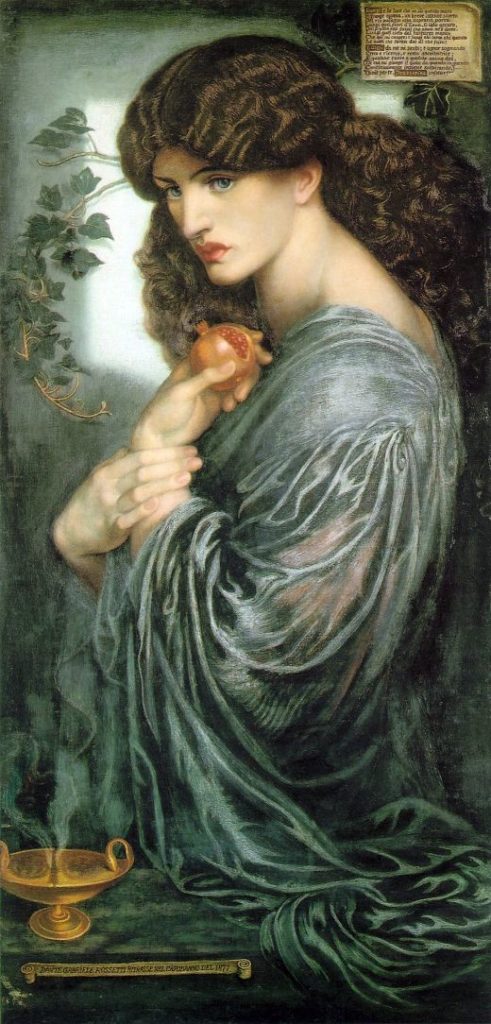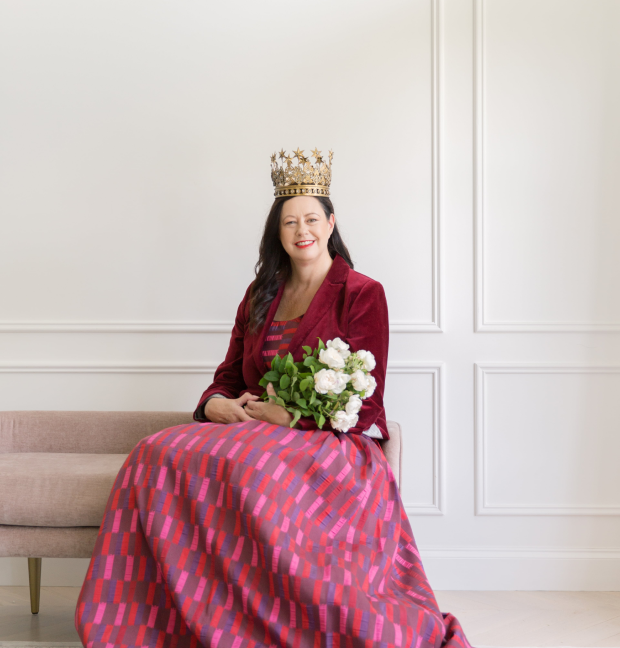
Jane Morris as ‘Proserpine’ Painted by Dante Gabriel Rossetti (1871)
Jane Morris was an English embroiderer and artists’ model who embodied the Pre-Raphaelite ideal of beauty, her face appearing on many paintings created by her husband William Morris and her lover Dante Gabriel Rossetti. She died on 26 January 1914, at the age of seventy-four. I have been fascinated with her since I was a teenager and first heard her story.
I was nineteen years old, an impoverished university student, living out of home for the first time, so poor I could scarcely afford to eat.
I was starved of beauty.
One day I saw a poster hanging in a shop window that stopped me in my tracks. A woman with heavy dark hair and a sorrowful face, loosely dressed in green silk, holding a pomegranate in her hand. The fruit had been split open to show the red pulp within. Behind her, a faint glimpse of light.
In the lower left-hand corner of the painting was a scroll inscribed with ‘Dante Gabriele Rossetti,’ a name I had never heard before.
In the upper right corner was some poetry written in Italian. I recognised the name ‘Proserpina’, another form of Persephone.
She was the goddess of spring, kidnapped by Hades and condemned to spend six months of the year in the underworld after eating just six pomegranate seeds. During her imprisonment, the whole world grew cold and barren. Winter clamped upon the earth for the first time.
It was my favourite Greek myth.
The poster was on sale for twenty-five dollars. I opened my wallet and saw that I was one dollar short. It was all the money I had. If I spent it I would not be able to eat for a week. But I knew I had to have it. The man in the shop agreed to sell the poster to me. As he rolled it up, I said timidly, ‘She’s very beautiful.’
‘Oh yes. She was famous for her face,’ he told me. ‘Rossetti painted her hundreds of times. They were madly in love, but she was married to one of his best friends and so they couldn’t be together.’
Beauty. Art. Myth. Poetry. Love. Heartbreak. It was all there, everything that most drew me, in that one richly coloured and mysterious painting.
So began my lifelong fascination with the Pre-Raphaelites.
The woman with the sorrowful face was named Janey Burden, and she was born in a slum in Oxford.
Her father was an ostler at an inn, her mother an illiterate laundress who signed her marriage certificate with an X. Janey lived with her parents and brother and sister in a single room not much bigger than the stalls where the horses were kept.
One evening in autumn 1857, to celebrate her eighteenth birthday, Janey and her sister Bessie went to see a travelling theatre group perform at the local gymnasium. There she caught the eye of an exotic-looking gentleman with ruffled dark curls and paint under his fingernails. His name was Dante Gabriel Rossetti. He was the eldest son of a fugitive Italian scholar, and the nephew of John Polidori, famous for being Lord Byron’s doctor and author of the infamous novel The Vampyre. Gabriel (as he was called by his friends) wanted to be both a poet and an artist, and divided his time between writing, drawing and roaming the streets looking for pretty girls.
By 1857, the Brotherhood had fallen apart but Gabriel had found a new circle of friends and admirers who had accompanied him to Oxford to paint some murals on the walls of Oxford Union’s debating hall. Among this new brotherhood were Edward Burne-Jones (then plain old Ned Jones) and William Morris (nicknamed Topsy). Ned and Topsy were best friends who had defied their families to pursue their dreams of art. They hero-worshipped Gabriel and followed his lead in everything.
As soon as Gabriel saw Janey, he was struck by her unconventional beauty. She was quite unlike the Victorian ideal of beauty, being tall as a man and slender as a willow wand, with heavy masses of dark hair, a bee-stung mouth, and a long strong nose. Her looks were so un-English that many would speculate that she had Gypsy blood in her. Gabriel accosted her at the end of the performance and asked her to come and model for him. After some hesitation, Janey agreed and changed her life forever.
Gabriel was ten years older than Janey, handsome, brilliant and charming. It was little wonder that she should fall in love with him. But Gabriel was not free. He had been entangled in a tumultuous affair with another woman for the past seven years.
Her name was Lizzie Siddal, and she was delicate, highly-strung and thought to be dying of consumption.
In all likelihood, her malady was anorexia nervosa but this was a psychological disorder that had not yet been identified, and so her frailty and refusal of food puzzled the many physicians who saw her. Lizzie was an artist and poet too, and had been the only woman to have her work exhibited in the first Pre-Raphaelite exhibition earlier that year.
Gabriel and Lizzie had become engaged a few years earlier, but somehow the marriage had never taken place. Hearing rumours about Gabriel and Janey, she wrote to him and begged him to come to her. Gabriel obeyed reluctantly. The Oxford set was broken up, the murals left unfinished. William Morris, however, stayed in Oxford. He was trying to paint Janey as the tragic queen Iseult.
Jane Burden, ‘Iseult’
By William Morris (1858)
One day he wrote on the back of the canvas, ‘I cannot paint you but I love you.’
Topsy was stout and rather awkward, but he was also kind and rich. Janey was a slum girl who had been abandoned by her lover. His offer of marriage was not something she could easily refuse. They were married in 1859, after Janey had spent months being taught how to act like a lady. She was the original Eliza Doolittle, and I mean that literally - George Bernard Shaw knew her well, and she inspired his play ‘Pygmalion’.
A year later Gabriel married Lizzie, after promising her on her death-bed that they would be wed if only she would get better. They had been lovers for more than eleven years.
A scant two weeks later, Ned married Georgie Macdonald, a sweet-faced nineteen-year-old who also dreamed of creating art. Topsy built a grand Art & Crafts manor in the Kentish countryside called Red House, and the three couples spent many happy weekends painting murals on the walls, embroidering tapestries, and playing hide-and-seek by candlelight. Together they created the company that is now known as Morris & Co, creating fabrics, wallpaper, stained glass, hand-painted tiles and furniture. Janey could embroider exquisitely, and she created many designs that helped make Morris & Co famous.
The joyous times could not last, however. Janey gave birth to a healthy little girl in January 1861, but - a few months later – Lizzie gave birth to a stillborn daughter. She sank deep into postnatal depression. One day Georgie and Ned found her rocking an empty cradle and singing lullabies to a baby who was not there.
Six months later, Lizzie died of a laudanum overdose. The inquest found death by misadventure, but rumours of suicide have abounded ever since. Racked with grief and guilt, Gabriel buried his only manuscript of poems with her. Haunted by her ghost, he painted her face compulsively and began to hold séances in the hope of reaching her. He filled his house with a menagerie of exotic animals – including peacocks, owls, raccoons and a wombat – and rarely left the house in sunlight. He drank too much and began to self-dose himself with chloral hydrate, a highly addictive sedative.
In the summer of 1865, Gabriel hosted a party at his grand house in Chelsea. Topsy and Janey were guests. Gabriel had not seen Janey since Lizzie’s death. Struck anew by her wild, dark beauty, Gabriel asked her to sit for him once again. Janey agreed at once. He began to paint her as obsessively as he once drawn Lizzie. In 1868, he created a magnificent portrait of her in a blue silk dress, a red rose at her waist. The frame was engraved with the words: “Famous for her poet husband, and most famous for her face, finally let her be famous for my picture!”
Portrait of Mrs William Morris in A Blue Silk Dress
Dante Gabriel Rossetti (c.1868)
By that time, Topsy had won great acclaim with his epic poem ‘The Earthly Paradise’. Jealous of his success and in love with his wife, Gabriel began to wish he had not been so impetuous in burying his own poetry in Lizzie’s coffin. In October 1869 – seven years after her death - Gabriel secretly obtained a court order to have her dead body exhumed so he could retrieve his manuscript, riddled with wormholes and reeking of rot.
One of the few remaining pages of Gabriel’s poetry manuscript which had been buried with Lizzie
– now at the British Library
The Victorians had a morbid fascination with death, which they policed with rigid mourning rituals. The news of the exhumation caused a scandal, fuelled by the whispers of Gabriel and Janey’s secret affair.
Cuckolded by his idol, betrayed by his wife, Topsy acted with his usual kindness and refusal to bow to convention. He took out a joint lease with Gabriel on a beautiful Elizabethan manor house on the River Thames in Kent, then travelled on his own to Iceland. Gabriel and Janey and her two daughters, Jenny and May, spent an idyllic summer at Kelmscott Manor, far from the outraged eyes of London society.
It was then that Gabriel began his portrait of Janey as Proserpina. In his eyes, she too was condemned to a loveless marriage, their world as bleak and barren as winter. Only in those few sweet heedless months of summer could they both escape and be free to love as they pleased. It was there that he wrote the sonnet later inscribed upon the painting. It read, in part, ‘this … dire fruit which, tasted once, must thrall me here … Woe’s me for thee, unhappy Proserpina’.
As the long summer days drifted past, Gabriel wrote many love poems for Janey. He copied them into a small leather notebook for her, each word thrumming with longing and desire: ‘all sweet blooms of love/To thee I gave while Spring and Summer sang;/But Autumn stops to listen, with some pang … Only this laurel dreads no winter days/Take my last gift; thy heart hath sung my praise.’
But the world could not be shut out.
The scandal intensified, with Gabriel’s art and poetry being excoriated in the press. Tortured by guilt, racked with insomnia, Gabriel had a nervous breakdown. In June 1872 – ten years after Lizzie’s death – he tried to commit suicide with an overdose of laudanum. He was revived, but was left paralysed down one side. His addiction to whisky, chloral and laudanum grew fiercer. In 1876, unable to bear it any longer, Janey broke off their affair.
In 1882, Gabriel painted Janey as Proserpina for the eighth and final time, except that he gave her Lizzie’s mane of fiery red hair.
A few days later, he died.
Janey lived for another thirty-odd years, spending much of her time in the old manor house on the river where she had been so happy so briefly.
She kept his notebook of love poems all her life.
It was this story which inspired me to write my novel ‘Beauty in Thorns’ which tells the little-known story of Georgie Burne-Jones, Jane Morris and Lizzie Siddal. You can read more HERE
and the book HERE

